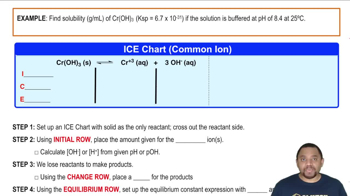Here are the essential concepts you must grasp in order to answer the question correctly.
Molar Solubility
Molar solubility refers to the maximum amount of a solute that can dissolve in a given volume of solvent at a specific temperature, expressed in moles per liter (mol/L). It is a crucial concept in understanding how substances interact in solution, particularly for sparingly soluble compounds like Ni(OH)2. The molar solubility can be influenced by factors such as pH and the presence of other ions in solution.
Recommended video:
pH and its Effect on Solubility
pH is a measure of the acidity or basicity of a solution, with lower values indicating acidic conditions and higher values indicating basic conditions. For metal hydroxides like Ni(OH)2, increasing the pH can enhance solubility by shifting the equilibrium of the dissolution reaction. At a pH of 12.0, the solution is basic, which can lead to increased solubility due to the formation of soluble nickel complexes.
Recommended video:
Solubility at Buffered pH Example
Equilibrium and Ksp
The solubility product constant (Ksp) is an equilibrium constant that applies to the dissolution of sparingly soluble ionic compounds. It quantifies the extent to which a compound can dissolve in water, represented by the concentrations of its ions at equilibrium. For Ni(OH)2, the Ksp expression involves the concentrations of Ni²⁺ and OH⁻ ions, and understanding this relationship is essential for calculating molar solubility under specific conditions, such as a buffered pH.
Recommended video:
 Verified step by step guidance
Verified step by step guidance


